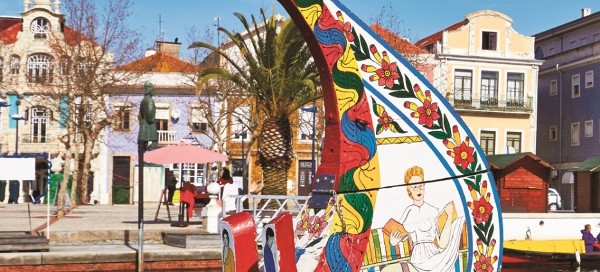Portugal certainly isn’t one of Europe’s biggest countries by size, and most visitors spend their time either on the beaches of the Algarve or in the lively streets of the historic capital, Lisbon. As a result, the rest of the country offers a pleasant, unhurried experience for those who choose to explore beyond the main attractions. Best of all, Portugal has many places which I suspect, if you put them in Italy or France, would attract many times the number of visitors they receive.
One such example is the city of Aveiro, some 5o miles south of Porto. Once an important sea port at the mouth of the Rio Vouga estuary, the city’s fortunes took a nose-dive after a major storm in the 16th century blocked the mouth of the river, creating a lagoon and swampland between the residents and the Atlantic. The population dwindled over the next 200 years, before a canal was constructed to restore Aveiro’s link the sea. The city recovered and became prosperous again, with wealthy merchants and businessmen building fancy homes along the city’s waterfronts.
Whether the label ‘Venice of Portugal’ is appropriate is open for debate, but what is undeniable is that Aveiro is an attractive, laid-back city with a rich history and plenty to warrant a few days of exploration. Here’s a quick look at some of the city’s highlights.
Canals and Moliceiros
Keeping with the Venice analogy, Aveiro’s answer to the gondola is the moliceiro. These colourful boats were originally employed to gather seaweed from the lagoon for use as a fertiliser. Nowadays their only cargo is tourists, and one of the main activities in Aveiro is a boat trip around the city’s canals to enjoy its many fine buildings from the water.
Architecture
The city’s renewed wealth came about at the turn of the 20th century – as a result, Aveiro now has one of western Europe’s best collection of art nouveau architecture. Take a walk (or a canal trip) to admire some of the more eye-catching buildings. Older than the art nouveau buildings but just as impressive, is the cathedral, covered in classic azulejo tiles and boasting an elaborate facade. Even older is the Jesus Monastery, set up as a female Dominican convent in the 15th century, and now home to the Aveiro Museum.
Mercado do Peixe
While a visit to a local fish market typically offers a noisy if somewhat smelly slice of local life, the real attraction in Aveiro’s fish market is the restaurant on site, which offers fresh, reasonably-priced seafood lunches in a buzzing atmosphere – you’re just as likely to sit with locals and students as you are with fellow visitors to the city.
Beaches
One of the main attractions of Aveiro, for Portuguese visitors at least, are the sandy beaches within easy reach of the city centre. Pretty wooden beach houses line the sandy spit, and the Atlantic waves are popular with surfers, while the inland lagoon is a favoured spot for windsurfing and kayaking. Even if you’re not one to spend a day lazing on the beach, the dunes offer plenty of hiking and are a home to a rich diversity of wildlife.
Aveiro is included in Sunvil Discovery’s 9-day Cultural Portugal itinerary.





